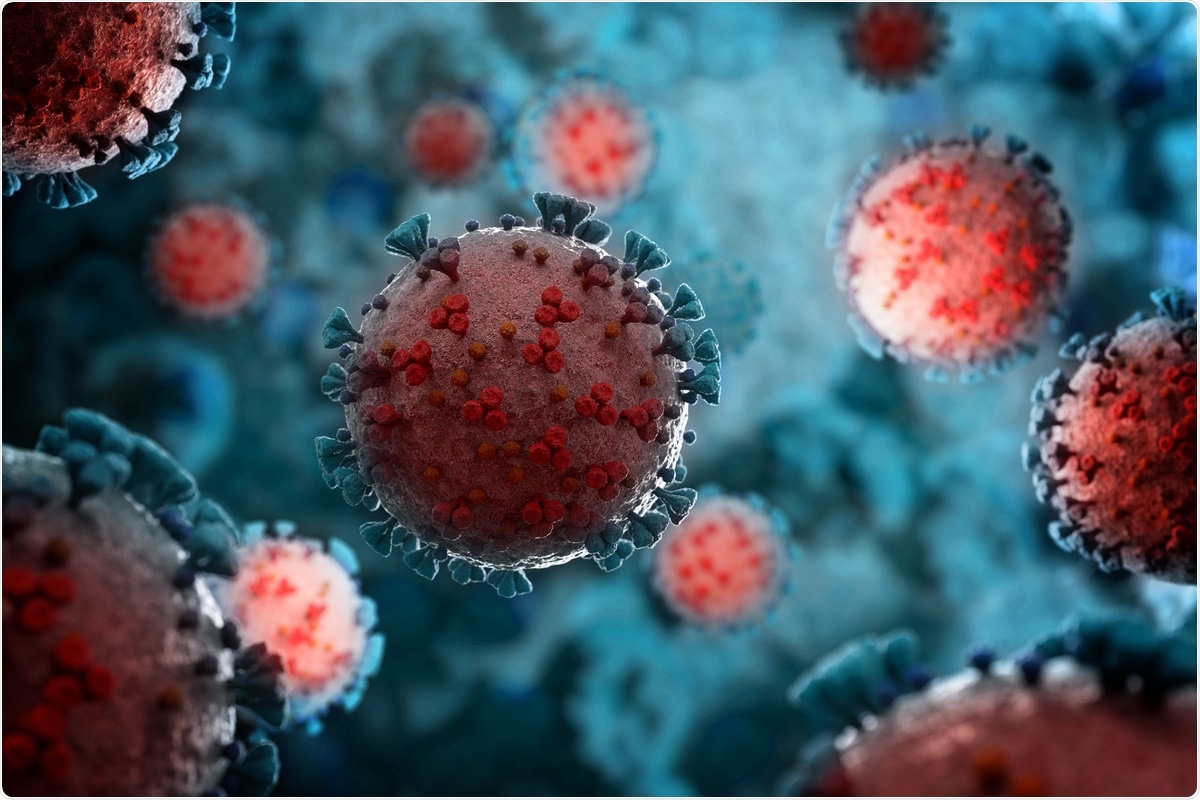The severe acute respiratory syndrome coronavirus 2 (SARS-CoV-2) infects host cells through a chemo-mechanical attachment to human cells, aided by human angiotensin-converting enzyme 2 (ACE2) receptor. After infecting host cells, this viral infection can progress into severe pneumonia with the potential to cause severe organ damage and death.
 Study: Molecular strategies for antibody binding and escape of SARS-CoV-2 and its mutations. Image Credit: sdecoret/ Shutterstock
Study: Molecular strategies for antibody binding and escape of SARS-CoV-2 and its mutations. Image Credit: sdecoret/ Shutterstock
Recent studies on sera of convalescent patients have revealed a large variety of effective human neutralizing antibodies (hNAbs) against SARS-CoV-2, targeting the spike (S)-protein, specifically its receptor-binding domain (RBD).
The study
A new study published in Scientific Reports investigated the mechanisms for binding and strategies to escape several hNAbs used by SARS-CoV-2 strains through molecular simulations.
In this study, five hNAbs – two in Classes I and II and one in Class III, were compared with the receptor-binding domain (RBD), including three mutations – N501Y (MT1), E484K and N501Y (MT2), and K417N, E484K and N501Y (MT3). These mutations resemble similarities with the novel strains B1.1.7, B1.1.28, and B.1.351, respectively. Additionally, mutations L452R and T478K, present in the delta variant (B.1.617.2), were also simulated in the RBD to deduce the binding energy with the ACE2.
This study focused on understanding the effect of the mutations on the binding to the ACE2 receptor. Analysis of the wild type (WT) and MT1 of the RBD and the ACE2 receptor revealed that the binding energy remains at similar levels and between the simulations’ margin error.
For MT2, MT3, and δδ RBD versions involving mutations – K417N, L452R, E484K, T478K, and N501Y, binding energies were higher than the WT. Hence, the strains B.1.35136 and B.1.617.237 could have a better binding avidity with the ACE2 receptor and easier access to host cells than the WT virus.
Additionally, multiple experiments using mutated RBD depict a more pronounced effect of the mutation E484. The binding between SARS2 and ACE2 increases when these mutations are present – K417N, E484K, L452R, T478K, and N501Y.
The observations also illustrated that the mutations increased the root mean square fluctuation (RMSF) near the mutation zone—suggesting more motion of the residues near the mutation. The larger values of the RMSF indicate contacts that are on and off at the interface in the mutated versions.
It was also found that class II and III hNAbs were the most effective to bind to the WT RBD. Considering that Class II and III link to different RBD areas, therapeutics strategies combining Class II and III could prove efficacious in aborting viral infection.
However, class II hNAbs showed a sharp decline in the binding energy to MT2 and MT3, owing to two main factors. Firstly, the loss of the salt bridge made by residue E484 and Class II hNAbs that use gene VH3-53 as a germline. Secondly, the reduced number of contacts between Class II and RBD makes the binding energy decay to low levels. This renders Class II antibodies inefficient in binding with the RBD. Therefore, Class II hNAbs are less effective in binding to the S-proteins within the B.1.351 strain.
The findings provide a molecular explanation for the mechanisms of binding between RBD and hNAbs and are in close agreement with the current experimental works.
Simulations between the RBD and Class I hNAbs demonstrated that the binding energy increases between MT1 (N501Y) and B38 and C102 compared to WT. This observation suggested that Class I hNAbs will remain effective to bind to the S-protein for the B.1.1.7 strain.
Moreover, the binding energy between B38 and C102 had different characteristics when analyzed with MT3. B38 had shown higher binding energy, while C102 showed binding energy significantly below the value found for the ACE2 receptor and MT3. Thus, C102 had less effectivity to bind to the mutated S-protein. Hence, C102 will be less effective in blocking viral infection for viruses with the B.1.351 lineage.
On investigating the effect of mutated S-proteins, it was found that mutation N501Y marginally enhanced the binding energy between RBD and ACE2, while mutations MT2, MT3, and δδ enhanced the binding affinity between RBD and ACE2. This could partially explain the rapid global propagation of the B.1.351, B.1.617.2, and δ strains.
This study also investigated the mutations’ effect on the binding affinity to several hNAbs, including – B38, C102 (Class I), P2B-2F6, and C144 (Class II). The lower affinity between mutated S-protein and these antibodies was projected, except for B38. Specifically, Class II antibodies showed a sharp decrease in their binding energy when mutations MT2-3 were simulated, thus reflecting a much lower efficiency to stop the viral infection.
Conclusion
The results indicate that modes of molecular bonding and binding between antibodies and RBD are numerous. Interestingly, Class III hNAbs have the largest binding energy to the wild type (WT) RBD, followed by Class II antibodies. Whereas Class I hNAbs generated slightly smaller binding energies. Therefore, binding energy levels are well segregated among different classes, and all hNAbs produce similar or higher binding energies than the RBD/ACE2 receptor
Journal reference:
-
Hendy, M., Kaufman, S. & Ponga, M. (2021), “Molecular strategies for antibody binding and escape of SARS-CoV-2 and its mutations”, Scientific Reports, 11, 21735, doi: 10.1038/s41598-021-01081-0, https://www.nature.com/articles/s41598-021-01081-0